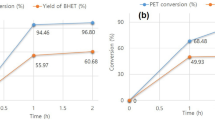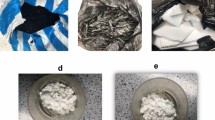Abstract
Depolymerization of polyethylene terephthalate (PET) is a promising technology for producing recycled monomers. Using a deep eutectic solvent (DES)-based catalyst, the PET glycolysis process produces bis-(2-hydroxyethylene terephthalate) (BHET). This recycled monomer reacts with isocyanate and forms polyurethane foam (PUF). The DES-based one-pot reaction is advantageous because it is a low-energy process that requires relatively lower temperatures and reduced reaction times. In this study, choline chloride/urea, zinc chloride/urea, and zinc acetate/urea based DESs were adopted as DES catalysts for glycolysis. Subsequently, the conversion of PET, BHET yield, and OH values were evaluated. Both filtered and unfiltered reaction mixtures were used as polyols for PUF polymerization after characterization of the acid and hydroxyl values of the polyols, as well as the NCO (–N=C=O) value of isocyanate. In the case of unfiltered reaction mixtures, PUF was obtained via a one-pot reaction, which exhibited higher thermal stability than PUF made from the filtered polyols. This outcome indicated that oligomeric BHET containing many aromatic moieties in unfiltered polyols contributes to the thermal stability of PUF. This environmentally friendly and relatively simple process is an economical approach for upcycling waste PET.








Similar content being viewed by others
Data Availability
The datasets used and/or analyzed are available from the corresponding author upon reasonable request.
References
Chamas A, Moon H, Zheng J, Qiu Y, Tabassum T, Jang JH, Abu-Omar M, Scott SL, Suh S (2020) Degradation rates of plastics in the environment. ACS Sustain Chem Eng 8:3494–3511
Keijer T, Bakker V, Slootweg JC (2019) Circular chemistry to enable a circular economy. Nat Chem 11:190–195
Shojaei B, Abtahi M, Najafi M (2020) Chemical recycling of PET: a stepping-stone toward sustainability. Polym Adv Technol 31:2912–2938
Kárpáti L, Fogarassy F, Kovácsik D, Vargha V (2019) One-pot depolymerization and polycondensation of pet based random oligo- and polyesters. J Polym Environ 27:2167–2181
Lipik VT, Abadie MJM (2007) Polyethylene Terephthalate Chemical Recycling in the Melted State. Polym-Plast Technol Eng 46:695–701
Ahmad I, Mei TM (2009) Mechanical and morphological studies of rubber wood sawdust-filled UPR composite based on recycled PET. Polym-Plast Technol Eng 48:1262–1268
Guo Z, Lindqvist K, de la Motte H (2018) An efficient recycling process of glycolysis of PET in the presence of a sustainable nanocatalyst. J Appl Polym Sci 135:46285
Kawkumpa S, Saisema T, Seoob O, Trakankit C, Atorngitjawat P, Sakulsaknimitr W (2019) Synthesis of polyurethane from glycolysis product of PET using ZnO as catalyst. RMUTSB Acad J 7:29–39
Ünlü AE, Arıkaya A, Takaç S (2019) Use of deep eutectic solvents as catalyst: a mini-review. Green Process Synth 8:355
Smith EL, Abbott AP, Ryder KS (2014) Deep eutectic solvents (DESs) and their applications. Chem Rev 114:11060–11082
Wang Q, Yao X, Geng Y, Zhou Q, Lu X, Zhang S (2015) Deep eutectic solvents as highly active catalysts for the fast and mild glycolysis of poly(ethylene terephthalate) (PET). Green Chem 17:2473–2479
Yunita I, Putisompon S, Chumkaeo P, Poonsawat T, Somsook E (2019) Effective catalysts derived from waste ostrich eggshells for glycolysis of post-consumer PET bottles. Chem Pap 73:1547–1560
Sert E, Yılmaz E, Atalay FS (2019) Chemical recycling of polyethlylene terephthalate by glycolysis using deep eutectic solvents. J Polym Environ 27:2956–2962
Zhang Q, De Oliveira Vigier K, Royer S, Jérôme F (2012) Deep eutectic solvents: syntheses, properties and applications. Chem Soc Rev 41:7108–7146
Musale RM, Shukla SR (2016) Deep eutectic solvent as effective catalyst for aminolysis of polyethylene terephthalate (PET) waste. Int J Plast Technol 20:106–120
Rushell E, Tailor YK, Khandewal S, Verma K, Agarwal M, Kumar M (2019) Deep eutectic solvent promoted synthesis of structurally diverse hybrid molecules with privileged heterocyclic substructures. New J Chem 43:12462–12467
Parnica J, Antalik M (2014) Urea and guanidine salts as novel components for deep eutectic solvents. J Mol Liq 197:23–26
Esquer R, García JJ (2019) Metal-catalysed Poly(Ethylene) terephthalate and polyurethane degradations by glycolysis. J Organometall Chem 902:120972
Ertas K, Güçlü G (2005) Alkyd resins synthesized from glycolysis products of waste PET. Polym-Plast Technol Eng 44:783–794
Chee T-M, Tin Sin L, Bee S-T, Tee T-T, Kadhum AAH, Rahmat AR (2015) Roles of calcium, zinc, copper and titanium compounds on the degradation of polymers. Polym-Plast Technol Eng 54:441–461
Akdogan E, Erdem M, Ureyen ME, Kaya M (2019) Rigid polyurethane foams with halogen‐free flame retardants: thermal insulation, mechanical, and flame retardant properties. J Appl Polym Sci 47611
Ivdre A, Abolins A, Sevastyanova I, Kirpluks M, Cabulis U, Merijs-Meri R (2020) Rigid polyurethane foams with various isocyanate indices based on polyols from rapeseed oil and waste PET. Polymers (Basel) 12:738
Gunatillake PA, Adhikari R (2011) Biodegradable polyurethanes: design, synthesis, properties and potential applications. In: Felton GP (ed) Biodegradable polymers: processing, degradation and applications. Nova Science Publishers, Hauppauge, NY, pp 431–470
Borowicz M, Paciorek-Sadowska J, Lubczak J, Czupryński B (2019) Biodegradable, flame-retardant, and bio-based rigid polyurethane/polyisocyanurate foams for thermal insulation application. Polymers (Basel) 11:1816
Mukesh C, Mondal D, Sharma M, Prasad K (2014) Choline chloride–thiourea, a deep eutectic solvent for the production of chitin nanofibers. Carbohyd Polym 103:466–471
Liu B, Fu W, Lu X, Zhou Q, Zhang S (2018) Lewis acid-base synergistic catalysis for polyethylene terephthalate degradation by 1, 3-dimethylurea/Zn (OAc) 2 deep eutectic solvent. ACS Sustain Chem Eng 7:3292–3300
Auvergne R, Colomines G, Robin J-J, Boutevin B (2007) Synthesis and characterization of UV-curable resins from the glycolysis of PET: vinyl ether/maleate UV-curing system. Macromol Chem Phys 208:690–701
Colomines G, Robin J-J, Tersac G (2005) Study of the glycolysis of PET by oligoesters. Polymer 46:3230–3247
Hu Y, Wang Y, Zhang X, Qian J, Xing X, Wang X (2020) Synthesis of poly(ethylene terephthalate) based on glycolysis of waste PET fiber. J Macromol Sci A 57:430–438
Sert E, Yılmaz E, F.S.J.J.o.P. Atalay, t. Environment (2019) Chemical recycling of polyethlylene terephthalate by glycolysis using deep eutectic solvents. 27:2956–2962
Zhou L, Lu X, Ju Z, Liu B, Yao H, Xu J, Zhou Q, Hu Y, Zhang S (2019) Alcoholysis of polyethylene terephthalate to produce dioctyl terephthalate using choline chloride-based deep eutectic solvents as efficient catalysts. Green Chem 21:897–906
Wang Y-W, Shen R, Wang Q, Vasquez Y (2018) ZnO Microstructures as flame-retardant coatings on cotton fabrics. ACS Omega 3:6330–6338
Ning Y, Guo S (2000) Flame-retardant and smoke-suppressant properties of zinc borate and aluminum trihydrate-filled rigid PVC. J Appl Polym Sci 77:3119–3127
Schartel B (2010) Phosphorus-based flame retardancy mechanisms-old hat or a starting point for future development? Materials (Basel) 3:4710–4745
Neisius M, Liang S, Mispreuve H, Gaan S (2013) Phosphoramidate-containing flame-retardant flexible polyurethane foams. Ind Eng Chem Res 52:9752–9762
Duquesne S, Le Bras M, Bourbigot S, Delobel R, Camino G, Eling B, Lindsay C, Roels T, Vezin H (2001) Mechanism of fire retardancy of polyurethanes using ammonium polyphosphate. J Appl Polym Sci 82:3262–3274
Li M, Luo J, Huang Y, Li X, Yu T, Ge M (2014) Recycling of waste poly(ethylene terephthalate) into flame-retardant rigid polyurethane foams. J Appl Polym Sci. https://doi.org/10.1002/app.40857
Ye L, Zhang Y, Wang S, Gao G, Liu J, Zhou Y, Liu H (2014) Synergistic effects and mechanism of ZnCl2 on intumescent flame-retardant polypropylene. J Therm Anal Calorim 115:1065–1071
Funding
This research was funded by the Korea Research Institute of Chemical Technology and the Chung-Ang University Research Grant in 2020.
Author information
Authors and Affiliations
Contributions
PS analyzed and interpreted the data. SC and Elsa created the diagram and performed the experiments. SMG analyzed and interpreted the data, especially the kinetics. PS was a major contributor in writing the manuscript, and SMG supervised the project. All authors read and approved the final manuscript.
Corresponding author
Ethics declarations
Conflict of interest
The authors declare that they have no competing interests.
Additional information
Publisher's Note
Springer Nature remains neutral with regard to jurisdictional claims in published maps and institutional affiliations.
Rights and permissions
About this article
Cite this article
Lee, P.S., Kim, SC., Tikue, E.T. et al. One-Pot Reaction of Waste PET to Flame Retardant Polyurethane Foam, via Deep Eutectic Solvents-Based Conversion Technology. J Polym Environ 30, 333–343 (2022). https://doi.org/10.1007/s10924-021-02202-6
Accepted:
Published:
Issue Date:
DOI: https://doi.org/10.1007/s10924-021-02202-6




